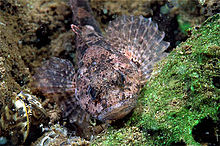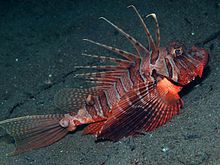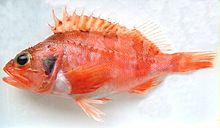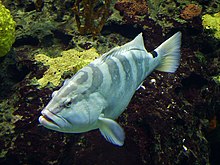Perciformes
The Perciformes (= Serraniformes sensu Li et al.), also called perch fishes, are an order of bony fishes. The taxonomic name is composed of the Greek "perke" (perch) and the Latin "forma" (form). Perch live both in freshwater and in the sea. The best-known Central European perch species include the perch and the pike-perch.
Perches have long been a poly- and paraphyletic collective taxon, housing all families that do not exhibit any of the derived characters that define the other spiny finfish or perch related orders. Nelson gives over 10,000 species, over 1500 genera, 160 families, and 20 suborders for the perches in the traditional sense. With one-third of the fish species, they were the largest fish order and also the most speciose order of vertebrates (Vertebrata).
In early 2013, Ricardo Betancur-R. and colleagues published a new systematics of bony fishes based on the comparison of nuclear and mitochondrial DNA, in which the Perciformes form a monophyletic taxon around the core group of perches (Percidae). Of all the remaining subtaxa assigned to the perciformes, only the sawfishes (Serranidae) and the petrels (Trachinidae), as well as the Antarctic fishes (Notothenioidei) and eelpout relatives (Zoarcales) remain. Instead, almost all of the families of the former armored cheeks (Scorpaeniformes) (except for the flying roosters (Dactylopteridae), which joined the lake needlefishes (Syngnathiformes)) were assigned to the perchfishes, as well as the sticklebacks (Gasterosteales), which are the sister group of the eel mother relatives. A few months later, Thomas J. Near and co-workers came to the same conclusion regarding the composition of the Perciformes in their work on the diversification and phylogeny of the Acanthomorphata.
Features
The body shape of the perch species can be very different. It can be moderately high-backed (perch), spindle-shaped (pike-perch) or elongated (eel-like). Typically, perch have two separate dorsal fins and an anal fin, the anterior portion of which is supported by spiny rays. An adipose fin is always absent. The pelvic fins are pectoral, but may be absent. The caudal fin has at most 17 fin rays. The body of most species is covered with ctenoid scales (comb scales), some families have cycloid scales (round scales). Scaleless species also occur. Bones, connective tissue ossifications between the muscle segments without contact to the spine, are absent.
Inner systematics
The following reflects the systematics of the perch species according to an update of the classification by Ricardo Betancur-R. and colleagues published in July 2017:
- suborder Bembropoidei
- Bembropidae
- suborder Normanichthyoidei
- Scaly Frog (Normanichthyidae)
- serranoids
- Seabass (Serranidae)
- Groupers (Epinephelidae)
- Caesioscorpididae
- Hemilutjanidae
- suborder Percoidei
- Niphonidae
- Perch (Percidae)
- Petrels (Trachinidae)
- Suborder Antarctic fish (Notothenioidei)
- Percophidae
- Pseudaphritidae
- Eleginopsidae
- Antarctic cod (Nototheniidae)
- Artedidraconidae
- Antarctic predatory fish (Harpagiferidae)
- Antarctic dragonfish (Bathydraconidae)
- Crocodile icefish (Channichthyidae)
- Icefish (Bovichtidae)
- Suborder Scorpaenoidei
- Wasp fish (Apistidae)
- Velvetfish (Aploactinidae)
- Pigfishes (Congiopodidae)
- Eschmeyeridae
- Gnathanacanthidae
- Neosebastidae
- Indian fish (Pataecidae)
- Perryenidae
- Scorpionfishes (Scorpaenidae)
- Spiny heads (Sebastidae)
- Setarchidae
- Stonefish (Synanceiidae)
- Frontal Finfish (Tetrarogidae)
- Zanclorhynchidae
- Suborder Platycephaloidei
- Deep-sea flatheads (Bembridae)
- Spiny Flatheads (Hoplichthyidae)
- Sprat Flatheads (Parabembridae)
- Flatheads (Platycephalidae)
- Spiny Flatheads (Plectrogeniidae)
- Suborder Triglioidei
- Gurnards (Triglidae)
- Suborder Cottoidei (= Cottimorpha sensu Li et al.)
- Suborder Anoplopomatales
- Skilfish (Anoplopomatidae)
- Suborder Stichlingsartige (Gasterosteales)
- Hypoptychidae
- Aulorhynchidae
- Sticklebacks (Gasterosteidae)
- Sub-order Eelpout relatives (Zoarcales)
- Ronquils (Bathymasteridae)
- Cebidichthyidae
- Spiny backs (Stichaeidae)
- Zaproridae
- Wrymouths (Cryptacanthodidae)
- Snake spine (Lumpenidae)
- Opisthocentridae
- Butterfish (Pholidae)
- Neozoarcidae
- Sea wolves (Anarhichadidae)
- Eel nuts (Zoarcidae)
- Eulophiidae
- Ptilichthyidae
- Scytalinidae
- Suborder Hexagrammales
- Greenlings (Hexagrammidae)
- Suborder Zaniolepidoales
- Zaniolepididae
- Suborder Groppenverwandte (Cottales)
- Armoured Bustards (Agonidae)
- Bullhead (Cottidae)
- Hares (Cyclopteridae)
- Jordaniidae
- Disc bellies (Liparidae)
- Thickheaded Grasshopper (Psychrolutidae)
- Rhamphocottidae
- Scorpaenichthyidae
- Trichodontidae
| Phylogenetic systematics of the perch species according to Near et al. 2012 u. 2015: | |||||||||||||||||||||||||||||||||||||||||||||||||||||||||||||||||||||||||||||||||||||||||||||||||||||||||||||||||||||||||||
|

Bullhead (Cottus gobio)

Sea stickleback (Spinachia spinachia)
.jpg)
Atlantic butterfish (Pholis gunnellus)

Striped gurnard (Trigloporus lastoviza)

Bluefin firefish (Parapterois heterura)

Blue Mouth (Helicolenus dactylopterus)

Giant Antarctic cod (Dissostichus mawsoni)
.jpg)
Bembrops anatirostris

Nassau grouper (Epinephelus striatus)
Questions and Answers
Q: What is the largest order of vertebrates?
A: The largest order of vertebrates is the Perciformes.
Q: How much of the bony fish do they have?
A: They have about 40% of all bony fish.
Q: What does Perciformes mean?
A: Perciformes means perch-like.
Q: What class do they belong to?
A: They belong to the class of ray-finned fish.
Q: How many species do they have?
A: They have over 7,000 species.
Q: What is the range of sizes of Perciformes?
A: They have the widest range of sizes of any order of vertebrates, ranging from the 7 mm Schindleria brevipinguis to the 5 metre Makaira species.
Q: What are some well-known members of the group of Perciformes?
A: Some well-known members of this group are angelfish, barracuda, bass, blenny, cichlids, damselfish, filefish, goby, grouper, remora, swordfish, mackerel, pufferfish, tilefish, tuna, whiting, and of course perch.
Search within the encyclopedia